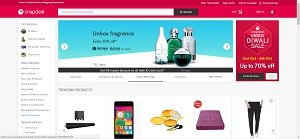Online major Snapdeal has gone in for an image makeover with a new-look logo that’s high on aesthetics and vision. It’s a sign of the times that a startup, which has arrived on the big stage, has decided to acquire a new look with a new meaning. However, all that will hold good only for as long as Snapdeal is able to ride the wave of competition successfully.

to grow to 100 million in the next couple of years.
The upside of any rebranding exercise is that it brings out something new. The recent Snapdeal rebranding has brought in a brand new logo, look and feel to the app, strategy, communication and much more. To sum up, everything about the brand has been lent a fresh perspective. It definitely adds an excitement to the company and the category overall. But the most important part of it lies much beyond this: Has it been or will it be able to achieve the objectives with which it embarked on this entire exercise?
Whenever a brand owner asks me about a rebranding, the first thing that I ask is “Why change?” and if the answer is as vague as “we want to modernize a little bit” or “just to add some excitement back”, I tell them not to jump to conclusions but rather relook at the current business problems, rethink the strategy and then decide the path to tread. While a rebrand sounds fancy, a lot of things are at stake including a lot of money, and it needs to be done, if at all required, very thoughtfully.
Indian ecommerce coming of age: The timing
 There are around 50 million online buyers in the country at present and reports suggest that it is set to grow to 100 million in the next couple of years. The ecommerce market itself is growing at around 45% YOY and is expected to reach US$ 28 billion by 2020. So far, online retailers have been communicating around deals and discounts and trying to educate the Indian consumers about the benefits of shopping online and also trying to address their concerns like security. However, the market is evolving with changing times. So while fast deliveries, discounts, return policies and functional benefits are there, brands will have to offer something of higher order, so that they can stand out.
There are around 50 million online buyers in the country at present and reports suggest that it is set to grow to 100 million in the next couple of years. The ecommerce market itself is growing at around 45% YOY and is expected to reach US$ 28 billion by 2020. So far, online retailers have been communicating around deals and discounts and trying to educate the Indian consumers about the benefits of shopping online and also trying to address their concerns like security. However, the market is evolving with changing times. So while fast deliveries, discounts, return policies and functional benefits are there, brands will have to offer something of higher order, so that they can stand out.
 In the light of these aspects, rebranding seems apt. It is an attempt to engage with the new 100 million buyers on Snapdeal. Amazon, over the last year, has been hammering with its “Aur Dikhao” campaign, establishing itself as the platform with the widest variety. Its recent campaign “Apni Dukaan” plays purely on emotional quotient of trust and familiarity. On the other hand, the bigger competitor Flipkart is still trying to gain consumer loyalty by assuring authentic products and promising prompt delivery—playing on the functional side of the arena. The time was ripe for Snapdeal to take an emotional route—to occupy and own a space in the minds of the consumer. It is the emotional payoff which boosts the top-of-the mind recall value, which is critical when a consumer shops online as every ecommerce player is offering almost the same product line. Plus coming just before the festive season, which is the most profitable period for the category, the timing couldn’t have been better.
In the light of these aspects, rebranding seems apt. It is an attempt to engage with the new 100 million buyers on Snapdeal. Amazon, over the last year, has been hammering with its “Aur Dikhao” campaign, establishing itself as the platform with the widest variety. Its recent campaign “Apni Dukaan” plays purely on emotional quotient of trust and familiarity. On the other hand, the bigger competitor Flipkart is still trying to gain consumer loyalty by assuring authentic products and promising prompt delivery—playing on the functional side of the arena. The time was ripe for Snapdeal to take an emotional route—to occupy and own a space in the minds of the consumer. It is the emotional payoff which boosts the top-of-the mind recall value, which is critical when a consumer shops online as every ecommerce player is offering almost the same product line. Plus coming just before the festive season, which is the most profitable period for the category, the timing couldn’t have been better.
The insight
With the rebranding, Snapdeal is trying to reconnect to the aspirational consumer base in India after after the Amir Khan starrer “Dil ki Deal” campaign died out post the intolerance controversy. The Snapdeal Blog explains how, for them, each product that the Indian consumer buys on Snapdeal is much more than a transaction; in fact, more of a progress to an upgraded lifestyle.
I admire the way it has touch-based on the biggest moment of truth for their consumer—when they receive the delivery box and open it. This unboxing brings in an immense delight, sometimes radically changing a key aspect of their lives for better. While this could be true for any ecommerce player, being the first one to claim this territory is commendable. The idea is to own this space in consumers’ minds.
I believe the new tagline “Unbox Zindagi” captures the emotions of the aspirational Indian—who wants to break free from shackles and live to the full potential. They believe that the best part of their lives is yet to come. Their dreams are based on not where they come from but where they can reach. Snapdeal is positioning itself as their partner in their journey to unlock their true potential.
At a time when Amazon with its “Apni Dukaan” campaign is trying to make people feel at home and radically changing the firangi company perception, Snapdeal is also putting its best foot forward to connect with the Indian consumer, staying as close as possible to their heart.
The design and impact
Rebranding of these sorts are not limited to just an identity change or a tagline change. An entire brand identity system needs to be developed so that the logo, the app, the website, the user experience—all of them talks a similar language. And so is the case with Snapdeal—the unique shade of red, vermello is found at each and every consumer touch-point. Even the delivery boxes, the van and the delivery boy uniform have the new logo and vermello colour. Kunal Bahl, cofounder and chief executive officer, Snapdeal claims that every aspect of the business is going to change—even the customer service.
From a brand designer perspective, I feel that the logo could have been more thoughtful. The logo has two arrows forming a box, indicating progress, onwards and upwards. However, the way I see it, having a bigger arrow pointing backwards and downwards is definitely NOT a sign of progress. Plus twitter has been flooded with people recollecting similarities with other logos. Whether it unboxes new opportunities for the brand is yet to be seen.
This is a classic case of fascination of cash-rich Indian companies of getting the design done by an international agency even though the Indian design firms can do an equally good job, if not better.
However, a mere change in the identity will not help. Survival in this utterly competitive ecommerce space will need a thorough understanding of the pulse of the Indian consumer and innovations in the same context. Snapdeal is trying to stay relevant and this rebranding exercise is just an attempt to do so and even tap newer audience.












